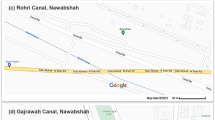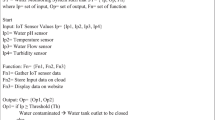Abstract
Water is a basic and primary resource which is required for sustenance of life on the Earth. The importance of water quality is increasing with the ascending water pollution owing to industrialization and depletion of fresh water sources. The countries having low control on reducing water pollution are likely to retain poor public health. Additionally, the methods being used in most developing countries are not effective and are based more on human intervention than on technological and automated solutions. Typically, most of the water samples and related data are monitored and tested in laboratories, which eventually consumes time and effort at the expense of producing fewer reliable results. In view of the above, there is an imperative need to devise a proper and systematic system to regularly monitor and manage the quality of water resources to arrest the related issues. Towards such ends, Internet of Things (IoT) is a great alternative to such traditional approaches which are complex and ineffective and it allows taking remote measurements in real-time with minimal human involvement. The proposed system consists of various water quality measuring nodes encompassing various sensors including dissolved oxygen, turbidity, pH level, water temperature, and total dissolved solids. These sensors nodes deployed at various sites of the study area transmit data to the server for processing and analysis using GSM modules. The data collected over months is used for water quality classification using water quality indices and for bacterial prediction by employing machine learning algorithms. For data visualization, a Web portal is developed which consists of a dashboard of Web services to display the heat maps and other related info-graphics. The real-time water quality data is collected using IoT nodes and the historic data is acquired from the Rawal Lake Filtration Plant. Several machine learning algorithms including neural networks (NN), convolutional neural networks (CNN), ridge regression (RR), support vector machines (SVM), decision tree regression (DTR), Bayesian regression (BR), and an ensemble of all models are trained for fecal coliform bacterial prediction, where SVM and Bayesian regression models have shown the optimal performance with mean squared error (MSE) of 0.35575 and 0.39566 respectively. The proposed system provides an alternative and more convenient solution for bacterial prediction, which otherwise is done manually in labs and is an expensive and time-consuming approach. In addition to this, it offers several other advantages including remote monitoring, ease of scalability, real-time status of water quality, and a portable hardware.















Similar content being viewed by others
Availability of data and materials
The data can be made available by requesting the authors through email.
References
Adamo, F., Attivissimo, F., Carducci, C. G. C., & Lanzolla, A. M. L. (2015). A smart sensor network for sea water quality monitoring. IEEE Sensors Journal, 15(5), 2514–2522.
Agarwal, A., Shukla, V., Singh, R., Gehlot, A., & Garg, V. (2018). Design and Development of Air and Water Pollution Quality Monitoring Using IoT and Quadcopter. In Intelligent Communication, Control and Devices (pp. 485-492). Springer, Singapore.
Ahmed, U., Mumtaz, R., Anwar, H., Mumtaz, S., & Qamar, A. M. (2020). Water quality monitoring: from conventional to emerging technologies. Water Supply, 20(1), 28–45.
Alamgir, A., Khan, M. A., Hany, O. E., Shaukat, S., Mehmood, K., Ahmed, A., & Ghori, M. (2015). Public health quality of drinking water supply in Orangi town, Karachi, Pakistan. Bulletin of Environment, Pharmacology and Life Sciences, 4(11), 88–94.
Ali, M., & Qamar, A. M. (2013). Data analysis, quality indexing and prediction of water quality for the management of rawal watershed in Pakistan. In Eighth International Conference on Digital Information Management (ICDIM 2013) (pp. 108-113). IEEE.
Baig, S. A., Lou, Z., Baig, M. A., Qasim, M., Shams, D. F., Mahmood, Q., & Xu, X. (2017). Assessment of tap water quality and corrosion scales from the selected distribution systems in northern Pakistan. Environmental Monitoring and Assessment, 189(4), 194.
Batabyal, A. K., & Chakraborty, S. (2015). Hydrogeochemistry and water quality index in the assessment of groundwater quality for drinking uses. Water Environment Research, 87(7), 607–617.
Chiu, W. (2019). When is R squared negative? https://www.quora.com/When-is-R-squared-negative/answer/William-Chiu
Clay, F. (2015). Is R-squared Useless? University of Virginia Library. https://data.library.virginia.edu/is-r-squared-useless/
Das, B., & Jain, P. C. (2017). Real-time water quality monitoring system using Internet of Things. In 2017 International conference on computer, communications and electronics (Comptelix) (pp. 78-82). IEEE.
Dascalescu, I. G., Morosanu, I., Ungureanu, F., Musteret, C. P., Minea, M., & Teodosiu, C. (2017). Development of a versatile water quality index for water supply applications. Environmental Engineering and Management Journal, 16(3), 525–534.
Daud, M. K., Nafees, M., Ali, S., Rizwan, M., Bajwa, R. A., Shakoor, M. B., & Malook, I. (2017). Drinking Water Quality Status and Contamination in Pakistan. BioMed Research International.
Dogo, E. M., Nwulu, N. I., Twala, B., & Aigbavboa, C. (2019). A survey of machine learning methods applied to anomaly detection on drinking-water quality data. Urban Water Journal, 16(3), 235–248.
Ejaz, N. A. E. E. M., Hashmi, H. N., & Ghumman, A. R. (2011). Water quality assessment of effluent receiving streams in Pakistan: A case study of Ravi River. Mehran University Research Journal of Engineering & Technology, 30(3), 383–396.
Faruq, M. O., Emu, I. H., Haque, M. N., Dey, M., Das, N. K., & Dey, M. (2017). Design and implementation of cost effective water quality evaluation system. In 2017 IEEE Region 10 Humanitarian Technology Conference (R10-HTC) (pp. 860-863). IEEE.
Frost, J. (2018). How To Interpret R-squared in Regression Analysis. Statistics By Jim. https://statisticsbyjim.com/regression/interpret-r-squared-regression/
Gazzaz, N. M., Yusoff, M. K., Aris, A. Z., Juahir, H., & Ramli, M. F. (2012). Artificial neural network modeling of the water quality index for Kinta River (Malaysia) using water quality variables as predictors. Marine Pollution Bulletin, 64(11), 2409–2420.
Geetha, S., & Gouthami, S. J. S. W. (2016). Internet of things enabled real time water quality monitoring system. Smart Water, 2(1), 1–19.
Hisam, A., Rahman, M. U., Kadir, E., Tariq, N. A., & Masood, S. (2014). Microbiological contamination in water filtration plants in Islamabad. Journal of the College of Physicians and Surgeons-Pakistan, 24, 345–350.
Horton, R. K. (1965) An index-number system for rating water quality, J. Water Pollut. Control Fed., 37, pp. 300–306.
Khatri, N., Sharma, A., Khatri, K. K., & Sharma, G. D. (2018). An IoT-based innovative real-time pH monitoring and control of municipal wastewater for agriculture and gardening. In Proceedings of First International Conference on Smart System, Innovations and Computing (pp. 353-362). Springer, Singapore.
Liu, J., Chen, H., Yao, L., Wei, Z., Lou, L., Shan, Y. & Zhou, X. (2016). The spatial distribution of pollutants in pipe-scale of large-diameter pipelines in a drinking water distribution system. Journal of Hazardous Materials, 317, 27–35.
Liu, L., Oza, S., Hogan, D., Perin, J., Rudan, I., Lawn, J. E., & Black, R. E. (2015). Global, regional, and national causes of child mortality in 2000–13, with projections to inform post-2015 priorities: an updated systematic analysis. The Lancet, 385(9966), 430–440.
Naqvi, J. (2017). Exposure to pollution kills millions of children. The Washington Post: WHO reports find https://www.washingtonpost.com/news/to-your-health/wp/2017/03/05/exposure-to-pollution-behind-millions-of-childrens-deaths-who-reports-find/.
Nelliyat, P. (2016). Water pollution: extent, impact, and abatement. In Indian Water Policy at the Crossroads: Resources, Technology and Reforms (pp. 131-151). Springer, Cham.
Rankovic, V., Radulovic, J., Radojevic, I., Ostojic, A., & Comic, L. (2010). Neural network modeling of dissolved oxygen in the Gruza reservoir. Serbia. Ecological Modelling, 221(8), 1239–1244.
Saha, H. N., Auddy, S., Chatterjee, A., Pal, S., Pandey, S., Singh, R., & Maity, A. (2017). Pollution control using internet of things (IoT). In 2017 8th Annual Industrial Automation and Electromechanical Engineering Conference (IEMECON) (pp. 65-68). IEEE.
Sakizadeh, M. (2016). Artificial intelligence for the prediction of water quality index in groundwater systems. Modeling Earth Systems and Environment, 2(1), 8.
Saravanan, M., Das, A., & Iyer, V. (2017). Smart water grid management using LPWAN IoT technology. In 2017 Global Internet of Things Summit (GIoTS) (pp. 1-6). IEEE.
Shafi, U., Mumtaz, R., Anwar, H., Qamar, A. M., & Khurshid, H. (2018). Surface water pollution detection using internet of things. In 2018 15th International Conference on Smart Cities: Improving Quality of Life Using ICT & IoT (HONET-ICT) (pp. 92-96). IEEE.
Shapiro, J. (2013). Chinese research perspectives on the environment. D. Yang (Ed.). Brill.
Sithole, M. P. P., Nwulu, N. I., & Dogo, E. M. (2019). Dataset for a wireless sensor network based drinking-water quality monitoring and notification system. Data in Brief, 27,.
Spanos A. (2019). Probability Theory and Statistical Inference: Empirical Modeling with Observational Data. Cambridge University Press. p. 635
Tadokoro, H., Jp, P. E., Nakamura, N., Nishimura, T., Uemura, K., Kikuchi, N., & Hatayama, M. (2017). Monitoring and Control Systems for the IoT in the Water Supply and Sewerage Utilities. Hitachi Review, 66, 704–711.
Verma, A. K., & Singh, T. N. (2013). Prediction of water quality from simple field parameters. Environmental earth sciences, 69(3), 821–829.
Vijai, P., & Sivakumar, P. B. (2016). Design of IoT systems and analytics in the context of smart city initiatives in India. Procedia Computer Science, 92, 583–588.
Vijayakumar, N., & Ramya, R. (2015). The real time monitoring of water quality in IoTenvironment. In Circuit, Power and Computing Technologies (ICCPCT), 2015 International Conference on (pp. 1-4). IEEE.
World Bank. (2005). Pakistan: Country Water Resources Assistance Strategy, Water Economy: Running Dry. Washington DC. World Bank. https://openknowledge.worldbank.org/handle/10986/8343 License: CC BY 3.0 IGO.
WHO (1993). Guidelines for drinking-water quality: second edition. Geneva: World Health Organization. ISBN: 924154460O.
Zeitoun, M. M., & Mehana, E. E. (2014). Impact of water pollution with heavy metals on fish health: overview and updates. Global Veterinaria, 12(2), 219–231.
Acknowledgements
This research work is conducted in NUST-SEECS, IoT Lab, Islamabad, Pakistan. We are indebted to the staff members of Rawal Lake Filtration Plant for extending their generous support in providing historic data.
Funding
This research work is funded by DAAD, Germany
Author information
Authors and Affiliations
Contributions
1. Hamza Khurshid: conceptualization, methodology, validation, investigation, writing–original draft, writing–review and editing, visualization. 2. Rafia Mumtaz: conceptualization, methodology, validation, investigation, writing–original draft, writing–review and editing, visualization, supervision. 3. Noor Alvi: conceptualization, methodology, investigation, writing–review and editing. 4. Ayesha Haque: software, validation, data curation, writing–original draft, writing–review and editing, visualization. 5. Sadaf Mumtaz: methodology, software, validation, investigation, writing–original draft. 6. Faisal Shafait: investigation, writing–review and editing, visualization. 7. Sheraz Ahmed: data curation, writing–review and editing, supervision. 8. Muhammad Imran Malik: investigation, methodology, validation, writing–review and editing. 9. Andreas Dengel: conceptualization, validation, visualization, writing–review and editing
Corresponding author
Ethics declarations
Ethics approval
The project does not involve any human or animal as the subject to be studied. Therefore, ethical approval is not applicable.
Consent to participate
The project does not require any involvement of living beings, therefore the consent to participate is not applicable.
Consent to publish
All the authors of the paper have given the consent to publish this work
Conflict of interest
The authors declare that they have no conflict of interest.
Additional information
Publisher’s Note
Springer Nature remains neutral with regard to jurisdictional claims in published maps and institutional affiliations.
Rights and permissions
About this article
Cite this article
Khurshid, H., Mumtaz, R., Alvi, N. et al. Bacterial prediction using internet of things (IoT) and machine learning. Environ Monit Assess 194, 133 (2022). https://doi.org/10.1007/s10661-021-09698-4
Received:
Accepted:
Published:
DOI: https://doi.org/10.1007/s10661-021-09698-4




